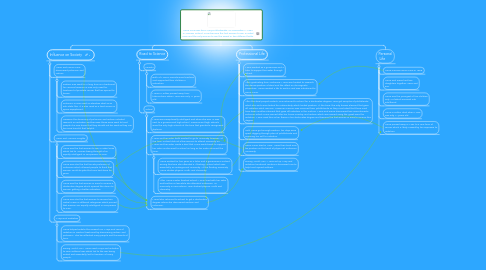
1. Influence on Society
1.1. Marie and Pierre Curie discovered polonium and radium.
1.1.1. Radium was used for a long time as a treatment for cancers however is now only used for treatment of prostate cancer that has spread to bones.
1.1.2. Polonium is now used on stainless steel as an anti-static film. It is also used as a heat source in space equiptment.
1.1.3. However the discovery of polonium and radium initiated research on radiation and because these were used to treat people it is now know that they should not be used as they can be more harmful that helpful.
1.2. Marie and Women's Rights.
1.2.1. Marie was the first women to win a Nobel Prize which led to Women being thought of as equally intelligent in comparison to men.
1.2.2. Marie was also the first female professor at Sorbonne which allowed people to think that women could do jobs that men had done for years.
1.2.3. Marie was the first woman in Paris to receive a doctorates degree which opened the doors to women getting a better education.
1.2.4. Marie was also the first woman to receive two Nobel Prizes in different categories which proved that women are equally intelligent in comparison to men.
1.3. X-rays and Radiation
1.3.1. Marie helped initiate the research on X-rays and uses of radiation in medical treatment by discovering radium and polonium. This has affected many people and thousands of lives.
1.3.2. During World War I Marie used x-rays and radiation to save soldiers lives which led to the war being ended and essentially led to freedom of many people.
2. Road to Science
2.1. Parents
2.1.1. Both of Marie's Parents were teachers and supported their children's education.
2.1.2. Marie's Mother passed away from tuberculosis, when Marie was only 11 years old.
2.2. School
2.2.1. Marie was exceptionally intelligent and when she was 14 was sent to a government high school. Government high schools were the only high schools at the time that granted a recognized diploma.
2.2.2. Marie and her sister both wanted to go to university however, at the time, Poland did not allow women to attend university, so Marie and her sister made a deal that Marie would work to support her sister as she went to school as long as her sister returned the favor.
2.2.2.1. Marie worked for five years as a tutor and a governess in Poland. During this time she attended a “floating” school which was essentially an underground university. At the floating university Marie studies physics, math, and chemistry.
2.2.2.2. After Marie's sister finished school, Marie lived with her sister and brother-in-law while she attended Sorbonne. An university in Paris where Marie studied physics, math and chemistry.
2.2.3. Marie later returned to school to get a doctorates degree where she discovered Radium and Polonium.
